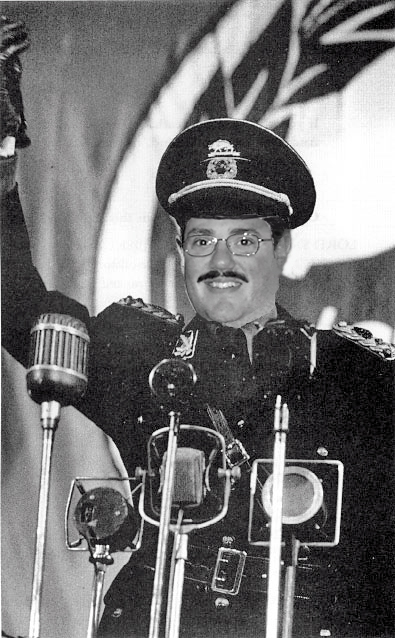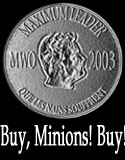Greetings, loyal minions. Your Maximum Leader must thank the many readers who commented on the Vermont Secession posts. Your Maximum Leader had no idea that there were so many hotbeds of secession around the nation. Although, to be honest, most of these movements are people wanting to create their own new state out of a portion of their old state (the Ole West Virginia/Virginia situation). Very few, including some secessionists in Texas and the aforementioned Vermont, actually seem to want out of the United States.
Well… Your Maximum Leader, as he’s stated before, will not let Vermont go peacefully. He’ll fight to keep Vermont in the Union. He’ll fight to maintain the Northeast Dairy Compact. Heck, we might need those Vermont dairy farmers to help keep the price of milk down (provided we could let market forces work outside of the Northeast Dairy Compact). Have you noticed food prices recently? Your Maximum Leader has. He spend $1.99 on a gallon of milk about three months ago. Today, he had to buy a gallon of milk (1% in case you care) and it was $2.95. Insanity!
The people at the Christian Science Monitor (and Yahoo News) have also noticed this price spike in food. In case you are too lazy to clicky on the linky:
The reason people are smarting: Inflation in grocery aisles is up by more in the first six months of 2007 than in all of 2006. That means food costs are on track for the biggest annual percentage hike since 1980, according to the Labor Department. The anticipated 7.5 percent increase would readily outflank the 2.6 percent core inflation rate to date, which excludes food and energy. It’s across every grocery aisle, too, from burgers to bagels, from duck to dumpling.Added to sticker shock at the gas pump, high food prices, especially for meat, are forcing consumers to scrimp, coupon-clip, and ponder the possibilities of a deep freeze to take advantage of discounts, says Boyd Brady, an extension agent at Auburn University in Alabama.
“There’s a … combination of higher demand, natural disasters, higher energy prices – just a myriad of factors driving what price increases we’re seeing across the food sector,” says Chad Hart, an agricultural economist at the Center for Agricultural and Rural Development in Ames, Iowa.
The chief culprit is corn, namely No. 2 feed corn, the staple of the breadbasket. In answer to President Bush’s call for greater oil independence, the amount of feed corn distilled into ethanol is expected to double in the next five to six years. Distillation is already sucking up 18 percent of the total crop. The ethanol gambit, in turn, is sending corn prices to historic levels – topping $4 per bushel earlier this year, and remaining high. All of this trickles down to the boards at the Chicago Mercantile Exchange, affecting the price of everything from sirloin to eggs (which are up, by the way, 18.6 percent across the nation).
In a welcome response, US farmers told the government in April they plan a record-breaking 93-million-acre corn crop, though its true size won’t be known until the end of June. But corn alone does not explain the number of products that have become more expensive of late.
Facing higher costs at the farm and shareholder pressure to maintain profits, companies such as Tyson Chicken and Coca-Cola are raising prices. The fact that fuel prices remain relatively high hasn’t helped either, allowing no break in the cost of transporting perishable goods.
For fruit and vegetable growers, labor shortages are also a factor. A $2 cantaloupe sold for $3 at the South Carolina Farmer’s Market in Greenville recently, largely because of labor woes, says Thompson Smith of the South Carolina Farm Bureau. Winter cold snaps and hard freezes in California and the Southeast have made peaches, apples, and oranges pricier.
In the heartland, low yields on winter wheat mean cookies and baguettes are more expensive. Meat costs are up by 15 percent in some regions, in part because of drought that, as in Alabama, caused a cattle sell-off. Milk prices are up in part because of a global shortage, with milk exporters such as New Zealand unable to add capacity and Australia enduring a debilitating drought, even as demand rises in Europe, China, and India.
Damn those people in Europe and China and India. Drinkin’ our friggin milk! Don’t they have clean drinking water over there? Oh… Yeah…
Anyho…
Although your Maximum Leader isn’t sure how a $2 cantaloupe is actually a $3 dollar cantaloupe (did some important information get edited out of that line?), he does see the price increases with frightening regularity. One wonders if we are going to see record price increases on victuals this year does that mean that farm subsidies will be lower? After all, some of these record prices must get to a farmer’s pocketbook…
Your Maximum Leader was joking there… He knows that subsidies aren’t changing… (Thanks Congress!)
Anyho… Moving back to the first point of this post… With record dairy prices coming and demand growing, we must keep Vermont in the Union. Damn those Vermalcontents, Your Maximum Leader will go up there and secure those dairy farms and keep the milk and cheese flowing. He’ll make sure that those cows are fed and milked at gunpoint if need be.
By the way… For those of you wondering what your Maximum Leader’s Colonel-in-Chief outfits might look like… We have a few styles to choose from… Here we go:
Your Maximum Leader in the style of the Virginia Militia (Colonial Era):

Your Maximum Leader in the style of British Colonial officer:

And your Maximum Leader in the style of a 1930s dictator (a la Ian McKellan’s Richard III):

You can take your choice as to which one you like best… Your Maximum Leader will make sure to take them all with him on campaign…
Watch out Vermoonbats! Your Maximum Leader’s got your number!
Carry on.



